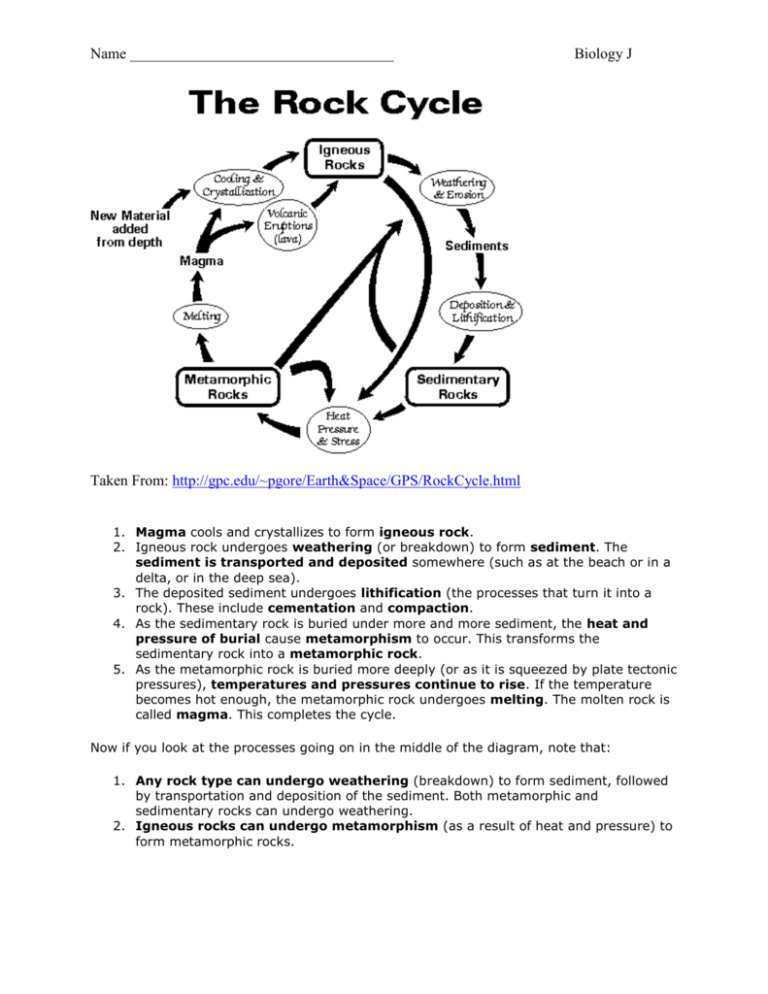Taken From: http://gpc.edu/~pgore/Earth&Space/GPS/RockCycle
advertisement

Name ___________________________________ Biology J Taken From: http://gpc.edu/~pgore/Earth&Space/GPS/RockCycle.html 1. Magma cools and crystallizes to form igneous rock. 2. Igneous rock undergoes weathering (or breakdown) to form sediment. The sediment is transported and deposited somewhere (such as at the beach or in a delta, or in the deep sea). 3. The deposited sediment undergoes lithification (the processes that turn it into a rock). These include cementation and compaction. 4. As the sedimentary rock is buried under more and more sediment, the heat and pressure of burial cause metamorphism to occur. This transforms the sedimentary rock into a metamorphic rock. 5. As the metamorphic rock is buried more deeply (or as it is squeezed by plate tectonic pressures), temperatures and pressures continue to rise. If the temperature becomes hot enough, the metamorphic rock undergoes melting. The molten rock is called magma. This completes the cycle. Now if you look at the processes going on in the middle of the diagram, note that: 1. Any rock type can undergo weathering (breakdown) to form sediment, followed by transportation and deposition of the sediment. Both metamorphic and sedimentary rocks can undergo weathering. 2. Igneous rocks can undergo metamorphism (as a result of heat and pressure) to form metamorphic rocks. http://www.seafriends.org.nz/enviro/soilgeosoil.htm Soil is a thin layer of material on the Earth's surface. Soil is a porous natural material made up of many materials including rocks, weathered minerals, and dead decaying plants and animals. The ratio of these materials varies from place to place depending on how it was formed. Soils are very old; they may be as old as 200,000 years, while other soil profiles are formed in as little as 2000 years. There are 5 soil forming factors; parent material, climate, organisms, location, and time. There are four main mineral types found in soil; sand, silt, clay, and loam. The soil is formed from varying combinations of "parent materials", possibly including several different types such as bedrock, organic material, old soil surface, or a deposit from water, wind, glaciers, volcanoes, or material moving down a slope. The climate is a major factor that helps in forming soil through weathering of rock and rate of decay of organisms. When weathering takes place, four components are released from the rock; minerals in solution (the basis of plant nutrition), oxides of iron and alumina, various forms of silica, and stable wastes as very fine silt (mostly fine quartz) and coarser quartz (sand). These have no nutritional value for plants. If the climate is favorable, the oxides of iron and alumina combine with silica to form clay, a new mineral. Decaying plants and animals add organic matter. In addition to adding organic matter to the topsoil, plants add hydrogen, helping the water percolate through and moving some parts of the minerals in the soil vertically. Microorganisms (bacteria, fungi, algae, protozoa and more) help breakdown plant matter producing carbon dioxide. Carbon dioxide mixed with moisture in the soil will dissolve mineral materials. Some bacteria also extract nitrogen from the air, to assist in plant growth. Insects, earthworms roundworms, millipedes, centipedes help decompose plant material by feeding upon it and loosening the soil by burrowing through it. Mice, squirrels, hares, caribou, moose, bison, camels, horses etc. all contribute to the enrichment of the soil also by depositing nitrogenrich waste with their feces. The location of where the soil is can determine how the climate affects the breakdown of the parent material. The drier soils are the ones that are facing the sun on slopes. At the bottom of a hill the soil is moister than the soils on the slopes. Soil Profile A cross section of the soil present in an area is called a soil profile. Every soil profile is made up of strata, or layers called soil horizons. This stratification reflects the progress of soil formation. The main horizons are A-horizon, B horizon, and C-horizon. Horizon A is the upper layer of soil at the surface of the earth's crust, more commonly known as topsoil. On top of the A-horizon is the O horizon made mostly of dead leaves (leaf litter) and which helps prevent erosion, and adds nutrients to the soil once it is broken down. http://www.seafriends.org.nz/enviro/soil/geosoil.htm#soil The A-horizon is made of mineral matter mixed with some humus (decomposed organic matter). You will find most plant roots and soil organisms in the A-horizon. It has very little nutrients because the nutrients have been used by plants or leached downward into the B Horizon. B-horizon, also called the zone of accumulation because it is the area where nutrients are leached from above, and new material from below accumulate. In the Bhorizon concentrations of clay, iron or organic matter can be found. Some lime may be present also. C-horizon is found below the B-horizon and is mainly made up of big rocks (parent material) that have been through some weathering process as it is breaking down to form new soil. Another view: Name ___________________________________ Biology J The Rock Cycle and Soil Formation Answer the following in the space provided. What is the ultimate source for all rock? Due to weathering, igneous rock becomes ____________________. Igneous or sedimentary rock can be converted by heat and pressure into __________________________________. What is soil? What is weathering? Can you have soil without the rock cycle? Explain. What is stratification? Explain what changes you see in the soil composition as you move down through the strata. How do biotic factors change the products of rock weathering into soil? Why do you think soil is a critical abiotic factor in an ecosystem?







